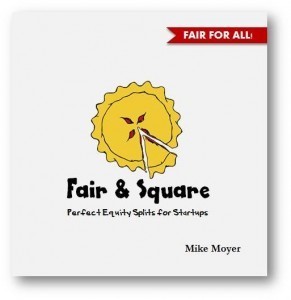Mike Moyer's Blog, page 12
December 1, 2014
The Slicing Pie Presentation Deck
Here are my most recent (December 2014) presentation slides for Slicing Pie. I update them from time to time!
Perfect Equity Splits for Startup Companies from Mike Moyer
November 16, 2014
Mike Moyer on Inspired Insider
I was happy to be interviewed on Inspired Insider by Jeremy Weisz. For those interested in a little back story!
November 14, 2014
Fair & Square
 While Slicing Pie is my definitive guide to dynamic equity splits, I’ve written a new book, called Fair & Square, that provides a more condensed description of the model and doubles as a user guide to the online Pie Slicer application.
While Slicing Pie is my definitive guide to dynamic equity splits, I’ve written a new book, called Fair & Square, that provides a more condensed description of the model and doubles as a user guide to the online Pie Slicer application.
If you would like to read a beta copy of the book, you may get one below at a reduced price in exchange for your feedback. The quantity of beta copies is capped so if the link below doesn’t work….sorry!
$5.00 – Buy the Beta Checkout
Added to cart
November 13, 2014
The Awkward Conversation
 In Slicing Pie, I refer to the “awkward conversation” that founder’s have about equity splits. The equity split negotiation is often the first major “deal” that founder’s do. I call them Alligator Pit negotiations. There are less-than alligators, who are are people who get less than what they deserve, and greater-than alligators, who are people who get more than they deserve. People approach equity negotiations the same way they approach alligator pits: with fear, caution and a keen interest towards self-preservation.
In Slicing Pie, I refer to the “awkward conversation” that founder’s have about equity splits. The equity split negotiation is often the first major “deal” that founder’s do. I call them Alligator Pit negotiations. There are less-than alligators, who are are people who get less than what they deserve, and greater-than alligators, who are people who get more than they deserve. People approach equity negotiations the same way they approach alligator pits: with fear, caution and a keen interest towards self-preservation.
This podcast, produced by Alex Blumberg, is a rare glimpse into a real-actual startup equity negotiation. It’s great!
Their final agreement (as you will see) is a traditional fixed split, which may cause problems down the road it they want to add additional team members or partners or angel investors want in the deal. I wish these guys had come across Slicing Pie in their research! If anyone has any ideas on how to improve my SEO let me know!
November 11, 2014
Dutch Pie
Slicing Pie is now available in Dutch thanks to Monique Wolters, Nick Stevens, Jolien Marinus, Marloes Pomp, Jeroen Sprangers and Arjan Yspeert. Thank you all very much for your hard work!
November 4, 2014
Slicing Pie Card Game

Playing the Slicing Pie Card Game in Kenya
One of the best ways to experience the mechanics of how a dynamic equity fund works is to experience it yourself by playing the Slicing Pie Card Game. The game simulates the events of a start-up company over an extended period of time. Each card specifies what an individual player did during that time and the Game Tracker spreadsheet allows players to track their contributions in much the same way they would in real life (with a few exceptions to keep the play simple).
In the game, participants experience successes and failures, just as they would in real life. Failures could easily drive the company out of business, but the right successes can generate millions! Habitual failure can lead to termination with cause, but sometimes players are terminated for other reasons. Terminated players must join another team.
I use this game sometimes in Slicing Pie workshops, it’s really fun!
To play the game, each player must access the online “Card Deck” at SlicingPie.com/deck. The online deck will allow you to choose cards and keep track of what has been played. Plus, you need one player to keep track of the contributions using the Game Tracker Worksheet on Excel or Google Docs.
Below is an overview of how the game is played:
After the game you and your team can review the results and discuss how each player’s contributions impacted the outcome of the game. Basic record-keeping is a real eye-opener when it comes to assessing success or failure. The results tab of the spreadsheet will allow you to compare the dynamic split against a traditional equal fixed split model.
I hope you enjoy the game! Please let me know if you have any comments!
October 31, 2014
Slices vs. Theoretical Value
 It’s important to know that a company’s value is not equal to the sum of the inputs. In other words, if I provide time, ideas and equipment worth $1,000, this doesn’t mean the company is worth $1,000. In most cases the value of a startup company is closer to zero. In all cases we hope it is worth much more than the inputs.
It’s important to know that a company’s value is not equal to the sum of the inputs. In other words, if I provide time, ideas and equipment worth $1,000, this doesn’t mean the company is worth $1,000. In most cases the value of a startup company is closer to zero. In all cases we hope it is worth much more than the inputs.
Implying a valuation means the underlying shares in a company also have value. This has meaningful tax implications and potential legal implications. It’s important, therefore, to understand that keeping track of contributions is simply a method used by the Slicing Pie model for calculating fair ownership or profit interests.
In the book Slicing Pie I refer to the base value as a theoretical value. This highlights the fact that the value is not real, it’s theoretical. To further avoid confusion, I have started using “slices” instead of theoretical value. Slices are determined by multiplying the fair market value of the contribution by the cash (4) or non-cash (2) multiplier.
Seed Stage Investments and the Well
Slicing Pie allocates slices of the pie when contributions to the company are put at risk. When you spend an hour working on company affairs, for instance, you are taking a risk that you will never get paid for your contribution. The amount of that risk is equal to the amount you would have otherwise been paid for the same contribution to a company that had the money to pay you. This is the fair market value of your time. All contributions have a fair market value and this serves as a basis for the calculations of slices in the pie (also known as theoretical value). In the Slicing Pie model, non-cash contributions (like time) use a 2x multiplier and cash contributions (like cash) use a 4x multipler. (If you have read Slicing Pie, this should all make sense).
Tracking cash contributions can be trickier. Traditionally, when a cash investment is made the investor gets a chunk of equity based on the current post-money valuation of the company. If no valuation is available (which is common in early-stage companies), investors accept a convertible loan agreement which means that their loan becomes equity if and when a valuation is agreed upon by larger investors.
In the Slicing Pie model, slices are granted when risk is taken. When an investor puts in money it’s not necessarily at risk if it’s simply sitting in the company account. The money is not at risk, therefore, until it is spent.
The “Well” is a model for tracking the investment of cash and converting it to slices. Using the model, cash investments are accepted as basic loans and the money is put into a corporate savings account or other secure account. When managers need cash to pay bills they transfer money from the Well into a checking account where it can be accessed. At this point, the money converts to slices at the 4x rate. At the same time, the balance of the loan reduces by that same amount.
If multiple investments are made into the Well, slices are allocated in proportion to ownership of the Well. For instance, if Mike invests $10,000 in the Well he gets no slices, just a loan agreement. The money goes into the corporate savings account. When the company manager takes $5,000 out of the savings account to pay bills, Mike receives 20,000 slices of the pie ($5,000 x 4) and his loan is reduced to $5,000. If Anne decides to invest $5,000 it is put in the savings account. Now the Well balance is back to $10,000, but Mike owns 50% and Anne owns 50%. The next month, when the manager withdraws $5,000, Mike gets half the slices and Anne gets the other half. So, they each get 10,000 slices ($2,500 x 4) this goes on until the funds in the Well are depleted.
The Well provides a mechanism to accept investment into a company using the Slicing Pie model so it will be on hand for future use. Investors get slices when and if the funds are used. This is fair and it properly aligns the interests of the managers and investors. Knowing that withdrawals from the Well convert to slices at the 4x rate makes managers think twice about how they are spending money. Careful financial management is a good thing!
You can buy Grunt Fund agreement and Well loan agreement templates from Slicing Pie. Your purchase includes both forms and a 1-hour consultation with David Coon, a Slicing Pie-friendly attorney!
$50.00 – Buy Now! Checkout
Added to cart
Below is a short video showing how the Well plays out using the Pie Slicer application.
The Magic of Mutipliers
For the Slicing Pie model, I recommend a non-cash multiplier of two (2) and a cash multiplier of four (4). Non-cash contributions include time, ideas, relationships and anything else that can be contributed without spending actual cash. Cash contributions include cash (when spent) and un-reimbursed expenses.
These numbers are set based on my personal experience with the model and they are important. There is no science or special math behind them, but I encourage you to resist the urge to change them! The multipliers make the model work. Without them, you will be less successful in achieving a fair split. There are two main purposes of the multipliers:
First, the multipliers assign a risk premium for the contributions. In a startup, the risk that you will never get paid is extremely high (almost 100%). To reflect that extremely high risk, for non-cash contributions the risk premium is twice what you put in. For cash it’s four times the contribution. Cash is given a higher premium because it’s much harder to save a dollar than it is to earn a dollar. The multipliers recognize the difference in scarcity between cash and non-cash contributions. This is critical to attract important investments of seed-stage cash. Savvy investors know that a person’s time at $100/hour isn’t quite the same thing as their crisp $100 bill.
Sometimes people think that the multipliers should change over time to reflect the possibility that risk goes down over time. Early contributions, they argue, are riskier than later contributions so the risk multiplier should go down over time. I completely understand the logic, but in practice startups are much too volatile to definitively ascertain a level of risk. Risk may appear to go down as traction is gained and revenue is generated. If a major customer cancels, however, risk may go up. Similarly, if a company grows so fast that they can’t provide a meaningful level of service risk could go up. Startups have so many ups and downs that trying to predict risk at any given time is futile. In the Slicing Pie model you have to measure what you can measure. Because of this I keep the multipliers constant.
The second purpose of the multipliers is to protect the company and the individual contributors from decisions one may make that adversely affect the other. This means that the multipliers effectively act as a retention program for the company and a severance program for employees.
If the company makes a decision that adversely affects an employee the result will be termination without good reason or resignation with good reason. In these cases, if the company wants the slices back they must pay the full amount with the multipliers. That means if you put $1,000 in the company has to pay $4,000 to get you out. This forces companies to think twice about pushing employees out.
In contrast, if the employee makes a decision that adversely affects the company the result will be termination for good reason or resignation without good reason. This means the employee loses slices received from non-cash contributions and loses the benefit of the 4x multiplier on cash contributions. This forces individual employees to think twice before quitting or slacking off on the job. Without the multipliers you lose this built-in protection for both parties.
Multipliers are a key part of why the Slicing Pie Model works so well for so many companies. They are the secret ingredient that makes the pie so delicious!
October 2, 2014
An Interview with Mike Moyer about Equity Splits
This video is part of a series called the Art of Dealmaking created by Fundology.com.



